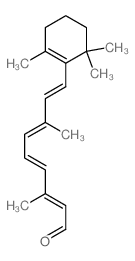13-顺式视黄醇

13-顺式视黄醇结构式

|
常用名 | 13-顺式视黄醇 | 英文名 | Retinal, 13-cis- |
|---|---|---|---|---|
| CAS号 | 472-86-6 | 分子量 | 284.43600 | |
| 密度 | 0.948g/cm3 | 沸点 | 421.4ºC at 760 mmHg | |
| 分子式 | C20H28O | 熔点 | 65-69ºC | |
| MSDS | 中文版 美版 | 闪点 | 205.4ºC | |
| 符号 |

GHS07 |
信号词 | Warning |
|
HEK293S cells have functional retinoid processing machinery.
J. Gen. Physiol. 119(6) , 593-612, (2002) Rhodopsin activation is measured by the early receptor current (ERC), a conformation-associated charge motion, in human embryonic kidney cells (HEK293S) expressing opsins. After rhodopsin bleaching in cells loaded with 11-cis-retinal, ERC signals recover in m... |
|
|
Probing human red cone opsin activity with retinal analogues.
J. Nat. Prod. 74 , 391-4, (2011) Retinal analogues have been used to probe the chromophore binding pocket and function of the rod visual pigment rhodopsin. Despite the high homology between rod and cone visual pigment proteins, conclusions drawn from rhodopsin studies should not necessarily ... |
|
|
Cantilever-based sensor for the detection of different chromophore isomers.
Anal. Chem. 79(12) , 4702-8, (2007) We report the use of microcantilevers (MCs) for the detection of three retinoid isomers: 9-cis-retinal, 13-cis-retinal and all-trans-retinal. Detection of synthetic and natural retinoids in topical cosmetic products is important, and their presence can be use... |
|
|
In vivo treatment with CPT-11 leads to differentiation of neuroblastoma xenografts and topoisomerase I alterations.
Cancer Res. 64(9) , 3223-9, (2004) Topoisomerase I inhibitors, such as CPT-11, are potent anticancer drugs against neuroblastoma (NB). Differentiating agents, such as retinoids, improve the survival of children with metastatic NB. To characterize the biological effects associated with exposure... |
|
|
FTIR study of the photoisomerization processes in the 13-cis and all-trans forms of Anabaena sensory rhodopsin at 77 K.
Biochemistry 45(14) , 4362-70, (2006) Archaeal-type rhodopsins can accommodate either all-trans- or 13-cis,15-syn-retinal in their chromophore binding site in the dark, but only the former isomer is functionally important. In contrast, Anabaena sensory rhodopsin (ASR), an archaeal-type rhodopsin ... |
|
|
Effect of retinoids on the growth of squamous cell carcinoma of the palate in rats.
Am. J. Otolaryngol. 7(1) , 55-7, (1986) The in vivo effects of retinoids on head and neck tumors were studied using Fisher 344 rats with squamous cell carcinoma implanted in the palate. Retinoids were given orally to rats, starting 2 weeks after tumor implantation. The animals were killed at 4 week... |
|
|
Growth factors and hormones which affect survival, growth, and differentiation of the MCF-7 stem cells and their descendants.
Exp. Cell Res. 181(1) , 116-25, (1989) The human breast tumor cell line was separated by Percoll density gradient centrifugation into six different subpopulations, A to F, one of which (E) appears to contain the stem cells on the basis of several criteria (M. Resnicoff et al. 1987, Proc. Natl. Aca... |
|
|
An amino acid residue (S201) in the retinal binding pocket regulates the photoreaction pathway of phoborhodopsin.
Biochemistry 50(33) , 7177-83, (2011) Phoborhodopsin from Halobacterium salinarum (salinarum phoborhodopsin, spR also called HsSR II) is a photoreceptor for the negative phototaxis of the bacterium. A unique feature of spR is the formation of a shorter wavelength photoproduct, P480, observed at l... |
|
|
Retinoids inhibit phospholipase A2 in human synovial fluid and arachidonic acid release from rat peritoneal macrophages.
Inflammation 14(5) , 543-59, (1990) Retinoids have demonstrated antiinflammatory activity in certain animal models and human disease states. The mechanism by which retinoids elicit this activity is unknown. Some retinoids are known to inhibit arachidonic acid (AA) release and metabolism in inta... |
|
|
All-trans to 13-cis retinal isomerization in light-adapted bacteriorhodopsin at acidic pH.
J. Photochem. Photobiol. B, Biol. 66(3) , 188-94, (2002) The flash photolysis kinetic spectra of the intermediate M(412) of bacteriorhodopsin were monitored during the process of acid titration. In the light-adapted state, the maximum peak amplitude of M(412) absorbance of bacteriorhodopsin decreased (pK(a)=3.40+/-... |